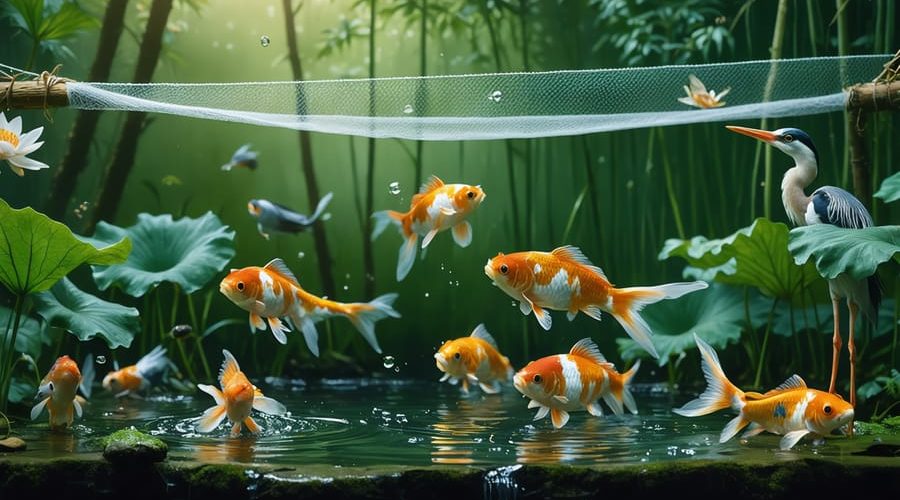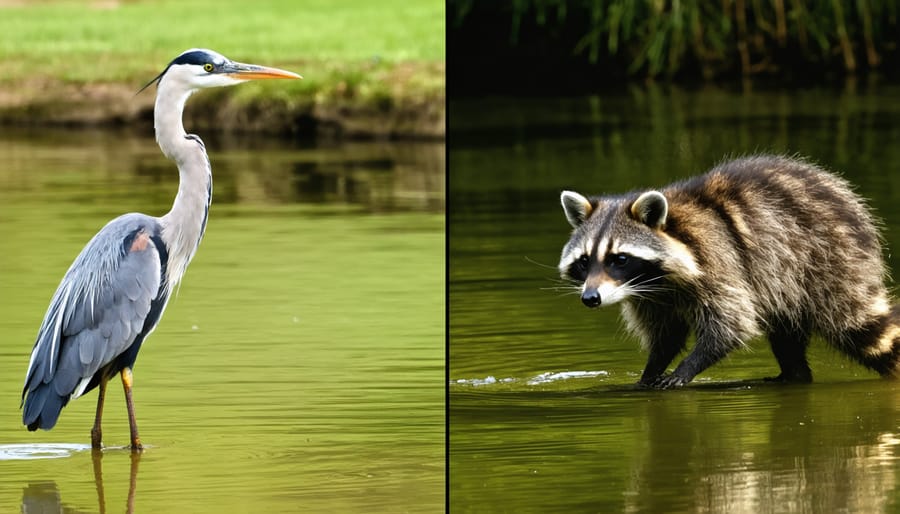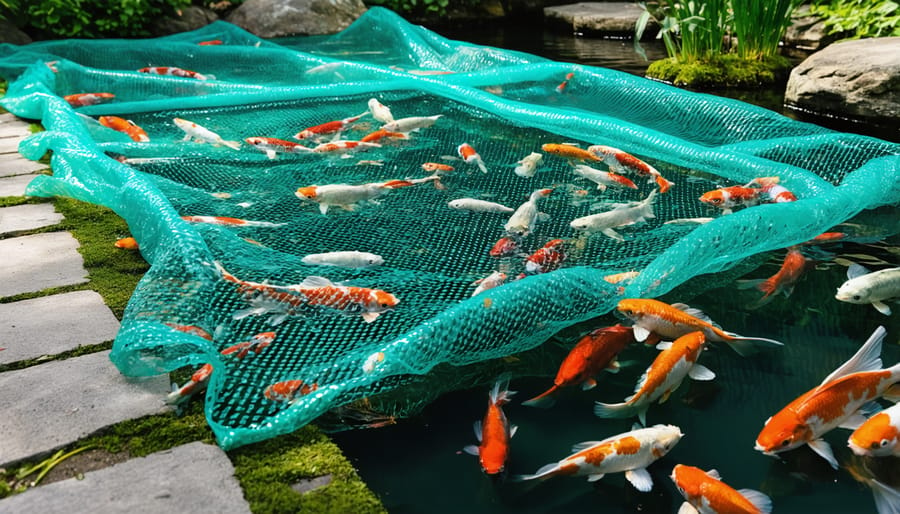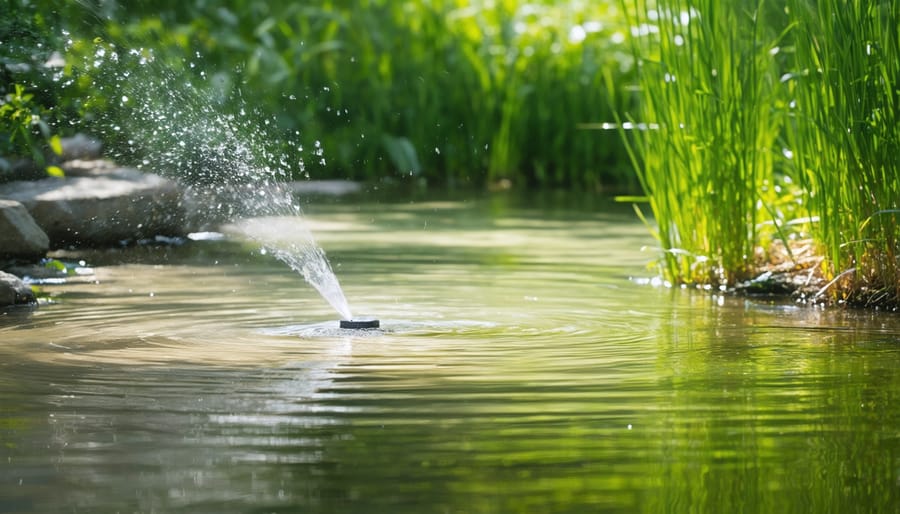
Keep Your Pond Fish Safe: Smart Protection from Natural Predators
Protecting your pond fish from predators requires a multi-layered defense strategy that combines both immediate safeguards and long-term solutions. From persistent herons to opportunistic raccoons, the threat to your finned friends is real – but so are the solutions. Installing a pond net creates an instant physical barrier while maintaining your pond’s natural beauty. Deeper water zones of at least 4 feet provide essential safe havens where fish can quickly retreat when danger lurks above. Strategic placement of floating plants, particularly water lilies and lotus, offers natural cover while enhancing your pond’s ecosystem. These protective measures not only shield your valuable koi and goldfish but also create a more balanced, sustainable water garden that brings peace of mind and lasting enjoyment. Whether you’re a seasoned pond keeper or just starting out, implementing these defensive strategies will help ensure your aquatic pets thrive under your watchful care.

Common Pond Predators: Know Your Fish’s Enemies
Airborne Threats
Birds are among the most persistent threats to pond fish, with herons being particularly notorious predators. These tall, patient hunters can stand motionless at the pond’s edge for hours, waiting for the perfect moment to strike. Kingfishers, while smaller, are equally dangerous with their swift diving abilities and precise hunting skills. Even common backyard birds like crows and magpies may occasionally try their luck with smaller fish.
To protect against these airborne hunters, consider installing a pond net suspended several inches above the water surface. This creates a physical barrier while remaining virtually invisible from a distance. Motion-activated sprinklers can also be effective, startling birds before they can settle near your pond. Decoy herons or floating predator deterrents can help too, though it’s important to move these regularly as birds may become accustomed to stationary decoys.
For a natural approach, creating deeper areas and adding floating plants gives fish plenty of hiding spots when shadows pass overhead.
Ground-Based Predators
Ground-based predators pose a significant threat to pond fish, with raccoons being one of the most persistent culprits. These clever creatures are excellent swimmers and can easily wade into shallow areas to catch fish. They typically hunt at night, leaving telltale signs like tracks around your pond and partially eaten fish remains.
Domestic and feral cats are another common threat, as they’re naturally attracted to movement in the water. While they prefer not to get wet, they’ll often perch on rocks or shallow edges to swat at fish swimming near the surface. Other potential predators include herons, mink, and even neighborhood dogs.
To protect against these land-based hunters, consider installing motion-activated sprinklers or lights around your pond. Creating steep sides with minimal shallow areas can also discourage predators from entering the water. Adding floating plants or placing rocks and driftwood near the edges gives fish quick hiding spots when they sense danger approaching.
Physical Barriers That Actually Work
Netting Solutions
Pond netting offers one of the most effective and affordable solutions to protect your fish from aerial predators. You can choose between two main types: floating nets and suspension nets. Floating nets rest directly on the water’s surface, while suspension nets are installed above the pond using poles or stakes.
For the best protection, select a net with a mesh size between 1/2 inch to 3/4 inch – small enough to keep birds out but large enough to allow insects and debris to pass through. Black netting is often preferred as it’s less visible and blends better with the landscape.
When installing your net, ensure it extends at least two feet beyond the pond’s edges to prevent predators from reaching under it. Create some slack in the netting rather than pulling it completely taut; this prevents birds from using it as a landing platform. Secure the edges with landscape pins or heavy rocks to prevent gaps.
For seasonal protection, consider using temporary stakes that can be easily removed. During spring and fall migration periods, when bird activity increases, you might want to double-layer your netting for extra security.

Protective Structures
Physical barriers provide excellent protection for your pond fish while maintaining the natural beauty of your water feature. Floating covers, such as rigid mesh or flexible netting, create a protective layer that prevents birds and other predators from reaching your fish. These covers can be easily installed and removed for maintenance, making them a practical choice for most pond owners.
Decorative domes add both protection and visual interest to your pond. Made from clear acrylic or wire mesh, these structures create safe zones where fish can retreat when they sense danger. For a more natural look, consider installing floating plants or lily pads, which serve as both hiding spots and attractive additions to your pond.
For smaller ponds, installing an overhead grid system using strong fishing line or thin wire can deter flying predators while remaining nearly invisible to the eye. Whatever structure you choose, ensure it’s properly secured and maintained to prevent sagging or damage that could compromise its effectiveness.
Natural Barriers
Creating a natural defense system through natural pond landscaping offers both protection and beauty for your fish. Plant tall marginal plants like rushes and reeds around the edges to create barriers against herons and other predatory birds. Floating plants such as water lilies and lotus provide essential cover for fish to hide underneath when they feel threatened.
Consider adding submerged plants like hornwort or anacharis, which create dense underwater forests where smaller fish can seek shelter. Strategically place rocks and driftwood around the pond’s edge and within the water to create hiding spots and escape routes for your fish.
For maximum protection, aim to cover about 60% of your pond’s surface with plants while maintaining clear areas for viewing and feeding your fish. This natural approach not only safeguards your finned friends but also creates a more balanced and aesthetically pleasing ecosystem that enhances your garden’s overall appeal.
Smart Prevention Strategies
Motion-Activated Solutions
Motion-activated sprinklers and lights are excellent deterrents that startle predators while being harmless to your fish. These smart solutions work by detecting movement around your pond, triggering an immediate response that sends predators scrambling.
A motion-activated sprinkler system delivers a quick burst of water when it senses movement, creating an unexpected shower that most predators find highly unpleasant. Position these sprinklers strategically around your pond’s perimeter, focusing on common entry points or areas where you’ve spotted predators before. They’re especially effective against herons, raccoons, and cats, who typically won’t return after a few surprise soakings.
Motion-sensing lights serve a dual purpose – they not only startle nighttime predators but also add beautiful illumination to your pond. When triggered, these lights suddenly flood the area with brightness, disrupting hunting attempts and making predators feel exposed. For best results, use warm-colored LED lights that won’t disturb your fish’s natural cycles.
Remember to adjust the sensitivity settings on both systems to avoid false triggers from wind-blown leaves or small insects. This helps conserve water and battery life while maintaining effective protection.

Pond Design Features
Creating safe zones in your pond is essential for protecting your fish from predators. Start by incorporating plenty of underwater plants like water lilies and submerged vegetation, which provide natural hiding spots. Add floating plants to create shaded areas where fish can retreat when they feel threatened.
Install various-sized rocks and caves at different depths throughout your pond. These structures give fish quick escape routes and secure spaces to hide. Consider adding underwater ledges or shelves that create shallow areas unreachable by wading birds.
A combination of deep and shallow areas is crucial – aim for at least one section that’s 4-5 feet deep, offering fish a safe retreat during winter and protection from aerial predators. Position decorative elements like hollow logs or ceramic pipes horizontally near the bottom to create additional hiding spots.
Remember to maintain clear sight lines from your house to the pond, making it easier to spot potential predators while adding to your viewing pleasure.
Maintenance Tips
Regular maintenance is key to ensuring your pond protection systems remain effective. Check netting weekly for tears or sagging, and immediately repair any damage to prevent opportunistic predators from gaining access. Inspect electric fences monthly, testing the charge and clearing any vegetation that might interfere with the circuit. If you use decoy predators, rotate their positions every few weeks to maintain their effectiveness – stationary decoys can lose their deterrent value over time.
Monitor your protective plants around the pond’s edge, trimming back any overgrowth that could provide hiding spots for predators. When maintaining a healthy pond environment, ensure water clarity remains good so fish can easily spot danger and access their shelter spots. Clean filters regularly and check that all hiding places, like floating plants or fish shelters, are secure and in good condition. Make it a habit to inspect your protection systems after severe weather events, as storms can damage or displace protective measures.
Emergency Response Plan
Despite our best preventive measures, predators can sometimes breach our defenses. When this happens, having solid emergency response strategies in place can mean the difference between saving your fish and losing them.
First, immediately check for any injured fish and move them to a quarantine tank if necessary. Use a net to carefully catch stressed fish that might be hiding in unusual spots. Keep a close eye on water quality during this time, as stressed fish are more susceptible to disease.
Next, identify the entry point the predator used and temporarily block it. This might mean adding extra netting, repairing damaged barriers, or placing temporary covers until you can implement a permanent solution. If you spot the predator, don’t try to handle it yourself – especially if it’s a large bird or mammal. Contact local wildlife authorities if needed.
Document the incident, including photos if possible, to help identify patterns and improve your protection strategies. Consider installing motion-activated lights or sprinklers as an immediate deterrent while you work on longer-term solutions.
Keep emergency supplies ready: extra netting, temporary covers, a quarantine tank, and basic first aid items for fish. Having these materials on hand allows you to act quickly when minutes count. Remember to regularly check and maintain these emergency supplies to ensure they’re ready when needed.
Protecting your pond fish from predators doesn’t have to be complicated or expensive. By implementing a combination of physical barriers, deterrent devices, and natural solutions, you can create a safe haven for your aquatic pets. Remember to regularly inspect your protective measures and adjust them as needed throughout the seasons. Whether you choose netting, floating decoys, or plants for coverage, the key is consistency in maintaining these protective elements. With proper planning and the right combination of methods, you can significantly reduce the risk of predator attacks while maintaining the beauty of your pond. Don’t wait until you’ve lost fish to take action – start implementing these protective measures today to ensure your pond remains a peaceful sanctuary for your finned friends.
